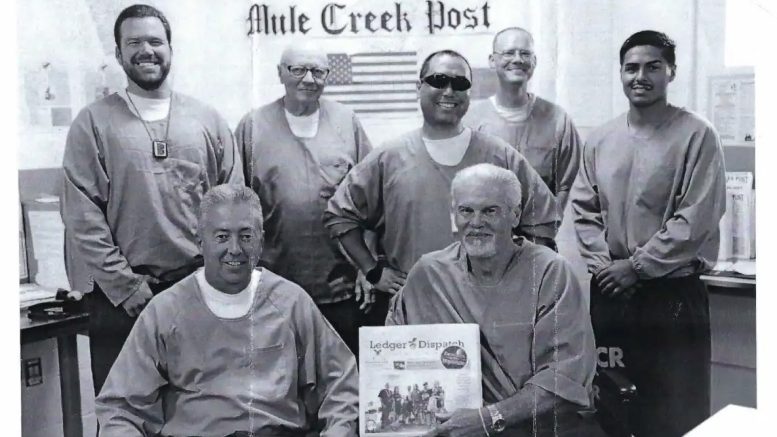Serving a life sentence, an incarcerated journalist has launched two prison newspapers and helped fellow inmates find self-worth and purpose.
By D. Razor Babb
This story is produced by the award-winning journalism nonprofit Capital & Main and co-published here with permission.
Los Angeles County Jail, 1998
As I lay atop the wire mesh fencing that covered the Los Angeles County Jail and peered over the side, the sight of the 60-foot drop sent a tsunami of anxiety and adrenaline through my body. It had taken six months of meticulous planning to reach this moment. No one had ever escaped from the ultra-high security section of the county jail known as High Power. I remember thinking, “If they’re gonna catch me, now would be a good time.”
When I arrived at state prison in 1999, on a high-security yard at the substance abuse treatment facility at Corcoran State Prison, I was looking down the wrong end of a life term. The light of day was barely conceivable, much less visible from the bottom of the pit I had dug for myself.
This is a place where might is right and the weak are prey for prison gangs, predators, psychopaths and inmate-hating guards. Just to make sure it wouldn’t be too easy a climb out of the pit, I was embarking on this journey as a paraplegic after a 60-foot fall from the roof of the L.A. County Jail during a failed escape attempt.
My ticket to hell had been hard earned. It was bought and paid for with a lifetime of bad choices, missteps, maladaptive thought processing and quite possibly a subconscious belief that this is what I deserved. Witnessing your mother being beaten and abused while cowering under bed covers crying in the dark and awaiting your own turn leaves gaping wounds of shame and guilt in a young boy’s mind. Not being able to come to the rescue of either one of us left a burning rage that I didn’t understand.
On my first night, I surveyed my surroundings and took stock of the options. Two things stared back at me from my reflection in the tiny, metal wall-mounted mirror. There was no place else to go but up, and, if I was going to crawl out of that dark hole, it was up to me to find a way.
The first order of business, besides avoiding getting stabbed or beaten to death, was to find a paying job. However, the fresh spinal surgeries and intolerable pain when sitting up had me largely bunk-ridden. They did give me a job, though — handing out checkers and Uno cards in the dayroom, at no pay.
I did have some legal experience, however, and quickly became immersed in correcting some of the failings at Corcoran, such as getting shower benches installed, having caregiver positions created, and establishing an Americans with Disabilities Act (paid) position on the Inmate Advisory Council. But when they awarded that position to a nondisabled confidential informant, I packed up the law books and moved on.
I had been studying Paramahansa Yogananda, an Indian-born Hindu mystic, as well as Dr. Wayne Dyer’s The Power of Intention. Dyer combines psychology with spirituality and mysticism. The teachings of these gurus emphasize the interconnectedness of all souls, the infinite nature of the universe. Through meditation and concentrated thought processes we are able to access energies and abilities that the uninitiated find difficult to grasp. It’s a no-limits philosophy based on heightened awareness and love. Existing in the higher planes of personal and infinite energy allows great things to manifest.
Looking around Corcoran, I saw the anger and hate, violence and a genuine lack of hope. Here I was, a paraplegic and seemingly at the bottom of the food chain, and yet, through meditation and application of these principles, I saw only potential and limitless possibilities. I wanted to share that, let the other inmates know that just because we were locked up didn’t mean we couldn’t do good things.
So I began writing, typing, editing, cutting and pasting the Corcoran Sun, a prison yard newspaper, from my cell in 2003. It was a mix of news, entertainment, self-help, legal updates and writing tips. I didn’t know it then, but in reaching out to help others, I would end up helping myself as well, filling me with purpose, self-worth and ultimately — redemption.
I had been a broadcast journalist on the streets since I was 19, working in newsrooms from Miami to Los Angeles for 20 years. So writing, typing and cutting and pasting a simple prison yard newsletter didn’t seem such a daunting task. I even included a monthly episodic action-adventure series called “Icicle Bill” using individuals on the yard, correctional officers and staff as inspiration for my characters.
A lot of the episodes were autobiographical, fictionalized and amped up. A close friend was the inspiration for Icicle Bill’s sidekick, Tommy Two-Head. The villain, Jimmy Fingers, was a composite of several of the prison yard tough guys, and Molly was the fantasy girl every criminal on the yard likely dreamed of.
It caught on quickly, and soon, customers were at my cell door looking for the next issue. I’d sell it on the yard for a cup of ramen soup and soon began adding more content to the Sun. A big-hearted Christian who went by the name “Ima Prayen” started making copies and mailing it to her contacts in prisons throughout the country. That distribution opened a network of correspondence from people sending in their stories and requesting subscriptions. I started selling ads to attorneys and pen pal and magazine sites, and I did ad trading with prisoner-oriented publications such as California Lifers Newsletter and Prison Legal News. I would spend mornings writing and pulling together the next edition of the Sun; afternoons were devoted to correspondence. I answered every letter, sent out promotional copies and solicited potential advertisers.
It wasn’t long before the Sun grew to 20 pages, and the number of “Icicle Bill” episodes expanded to the equivalent of novel length. I received stacks of mail daily, books of stamps for ad placements, checks sent to my trust account, even fan mail and love letters. Much of the mail came from fellow prisoners interested in the writing tips and prompts from Writer’s Digest magazine I included in the Sun. Readers wanted to get involved.
One advertiser, Inmate Classified, posted “Icicle Bill” on its website, where it developed a following. By the time a second series, “Goodbye Natalie,” was concluding (each series had 26 episodes), I had three offers to publish “Icicle Bill” and “Goodbye Natalie” in paperback. Meanwhile, the Sun was converted to a digital format that was accessible in prisons in all 50 states. Although it had taken several years to reach this point, I had been so busy that time seemed irrelevant. There were simply not enough hours in the day to do all that needed to be done.
When Icicle Bill was published, it was an unforgettable, life-changing moment for me. Though it took nearly three years to write Icicle Bill, it all seemed to be happening so fast. In contrast, Goodbye Natalie was completed and published in less than a year and was even more popular than the first book. It seemed to me that the next logical step would be to turn the books into screenplays, broker a movie deal, hire a high-powered attorney and buy my way out of prison.
Several books, a couple of prison newspapers and a dozen years later, I am still hacking away at news articles and working on revisions of book manuscripts, “Life: A Page at a Time” and “Voices From the Shadows: Class and Racial Struggle in the Era of Mass Incarceration,” and still doing it within the confines of walls and fences.
A lot has changed, however. Writing and publishing had not only taken over my life, it had completely changed it as well. Somewhere along the way I had discovered meaning as well as purpose and developed a sense of self-worth to the point where I now felt I was someone I wouldn’t mind other people knowing. The writing had built a path to redemption. The incredible support and shared experience with the publishing network, supporters and readers had pulled me out of the pit. I had experienced a transformation, literally, a page at a time, and I had fallen in love with the written word.
In 2015, I gave up control of the Corcoran Sun to Freebird Publishing and began concentrating on writing books full time, switching from fiction to self-help with the American Prisoner series. More than ever, I was focused on rehabilitation and getting out. The California Department of Corrections had implemented the Elderly Parole Program and, as fate would have it, at 68 I had become elderly as well.
I have been locked up since 1993, but the time has passed without notice. The author’s photo on the back cover of Icicle Bill shows a dark-haired version of the grizzled, irascible curmudgeon I have become.
In 2016, I was transferred to a medium security yard at Mule Creek State Prison, where programming and rehabilitation are the norm. It seems more like a college campus than the dangerous, high-security tiers I had navigated for so long. Aging ex-gangsters and gray-haired seniors, more at home playing chess or settling in with a good book and asleep by 8:30, trundle the track in walkers and wheelchairs. There’s a bachelor’s and master’s degree college prison program, dog training and pickleball tournaments. There is even a newspaper of some repute, now.
After arriving at Mule Creek I immediately began a push to establish a prison paper. With all the prison’s claims about the importance of rehabilitation and career development, it seemed a natural progression to fire up the old $100 Smith Corona, a personal typewriter that had seen better days but had carried me this far, and get the presses rolling again. In 12 or 13 years of publishing the Corcoran Sun I had never missed an issue, never blown a deadline. This time, I wasn’t alone. The administration at Mule Creek was amenable to cooperating, and we assembled an eclectic newsroom from the inmate population, most of them serving life terms. There was Jesse Carson, a talented artist and layout man as production editor; Franklin Lee, our sociable and outgoing lead reporter; Bob Von Villas, a financial genius I had known since Corcoran, who was our business reporter; and Ryan Kamflot, Matt Toerner, and Thomas Dunaway, who were all in from day one with the founding of the Mule Creek Post, which began publishing in January 2018.
By our sixth issue, Jack Mitchell, publisher of the Amador County Ledger Dispatch, was printing the Post in full color newspaper format. Joan Parkin from Feather River College became a supporter and adviser and assembled a journalism club of her college students who interned at the Post. Department of Corrections secretaries, a federal judge, numerous Department of Corrections delegations, educators, attorneys, sociologists and the just plain curious have now visited the Mule Creek newsroom. The Prison Journalism Project became a key supporter, as did the Pollen Initiative, which works to cultivate media centers inside prisons. We have built a network of associations that have contributed to a vision of the future we hope and believe will endure.
I have now retired from the editor’s desk to a more leisurely position as feature reporter. But I have watched as the crew grew into seasoned journalists, doing an admirable job producing the paper. Also reporting for Vanguard Incarcerated Press, the Prison Journalism Project and Empowerment Avenue, which helped publish this article, it is my hope to enable those involved in prison journalism, here and elsewhere, to transfer those skills into viable career options. The Mule Creek Post is primarily digital now and available on the Global Tel Link tablets provided to prisoners throughout California. We have at least 10 regular volunteer reporters and columnists aside from eight paid positions assigned by the prison. There are numerous outside contributors as well — attorneys, psychologists, academics, professional writers, business professionals. We wrote and facilitated the Incarcerated Journalist Training Program and have established a small journalism guild. What lies ahead for the Post is limited only by imagination and determination.
The rise in mass incarceration in the U.S. has heightened the importance of protecting speech, especially from inside prison walls. As outside news media struggles with their existential identities, being pushed, pulled, torn apart by commercial, social, technological and partisan political forces, prison journalism has become an essential element in a troubled democracy. Inside these walls is a microcosm of the greater social order and a proving ground for where democracy is headed. Pounding out cell-published editions of the Corcoran Sun, then later working with a team to produce the Post, I didn’t realize, at the time, that the civic ideals and principles I’d grown up on in the 1960s and ’70s centering on free speech, civil rights, holding truth to power, challenging unjust conditions and rejecting unfair autocratic systems would become such an important aspect of the writing and reporting, and that prison journalism would play a key role and be so important to the narrative … as we compose the manuscript that history will publish.
If we don’t stand up for what is right, for democratic ideals, we lose them… eroded away in increments, one silenced voice at a time. How we treat the least of us defines the rest of us. Information is the currency of democracy; it is through open discourse and a free exchange of ideas that we arrive at truth. The ideals and steady principles of fair, honest reporting and writing serve the public good, and journalists have to be brave in the face of criticism.
As a reporter and a writer I believe we have an obligation to advocate for free speech, regardless of personal opinion or our own welfare, in this way we help create a world where mass incarceration has no place. Along the way, if we’re lucky, maybe we discover our own and our collective humanity.
D. Razor Babb is an inmate at Mule Creek State Prison. He is the founding editor of the Mule Creek Post and a social justice reporter for the Prison Journalism Project, the Davis Vanguard Incarcerated Press and Empowerment Avenue.
Copyright 2024 Capital & Main.






Nowhere does he admit the crime that got him a life sentence. No applause for him or his self-congratulation. Showcase real journalists, not criminals.